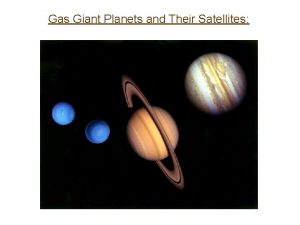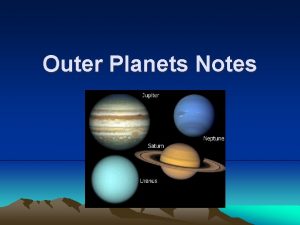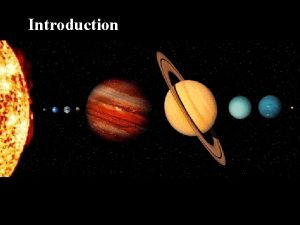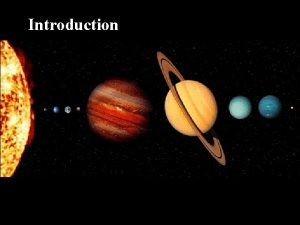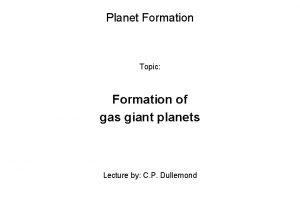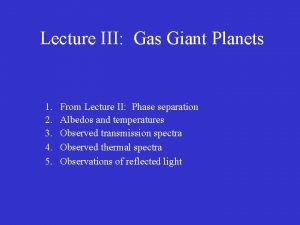On the Frequency of Gas Giant Planets in



![Globular Cluster 47 Tucanae 11 Gyr, 106 stars [Fe/H] ~ - 0. 7 HST/WFPC Globular Cluster 47 Tucanae 11 Gyr, 106 stars [Fe/H] ~ - 0. 7 HST/WFPC](https://slidetodoc.com/presentation_image_h2/ec9235a1a6190132e33762b7d1b56dbb/image-4.jpg)

![Fp vs [Fe/H] Linear Dependence? Flat tail for [Fe/H] < 0. 0? Low statistics Fp vs [Fe/H] Linear Dependence? Flat tail for [Fe/H] < 0. 0? Low statistics](https://slidetodoc.com/presentation_image_h2/ec9235a1a6190132e33762b7d1b56dbb/image-6.jpg)
![Small-number statistics for [Fe/H] < -0. 5 prevents one from drawing conclusions: Is Fp([Fe/H]) Small-number statistics for [Fe/H] < -0. 5 prevents one from drawing conclusions: Is Fp([Fe/H])](https://slidetodoc.com/presentation_image_h2/ec9235a1a6190132e33762b7d1b56dbb/image-7.jpg)


![No clear RV trends are seen as a function of Teff, [Fe/H], and ΔT No clear RV trends are seen as a function of Teff, [Fe/H], and ΔT](https://slidetodoc.com/presentation_image_h2/ec9235a1a6190132e33762b7d1b56dbb/image-10.jpg)




![Frequency of Close-in Companions (-2. 0<[Fe/H]<-0. 6, K > 100 m/s, P < 3 Frequency of Close-in Companions (-2. 0<[Fe/H]<-0. 6, K > 100 m/s, P < 3](https://slidetodoc.com/presentation_image_h2/ec9235a1a6190132e33762b7d1b56dbb/image-15.jpg)



- Slides: 18

On the Frequency of Gas Giant Planets in the Metal-Poor Regime Alessandro Sozzetti 1, D. W. Latham 2, G. Torres 2, R. P. Stefanik 2, S. G. Korzennik 2, A. P. Boss 3, B. W. Carney 4, J. B. Laird 5 (1) INAF/OATo - (2) Cf. A - (3) CIW - (4) UNC - (5) BGSU Pisa, 6 May 2009

Core Accretion & Disk Instability * Core Accretion: Bottom-Up! Accumulate a 10 M core (dust to planetesimals to runaway accretion), which accretes a massive gaseous envelope from the disk. * Disk Instability: Top-Down! Local gravitational collapse of a gaseous portion of the disk leads to a Jupiter-mass (or larger) protoplanet. The rocky core is formed almost simultaneously by sedimentation of dust grains to the center. Boss (SSRv, 2005) Pisa, 6 May 2009

Do giant planets form by Core Accretion, Disk Instability, or both? Ida & Lin (Ap. J, 2004), Kornet et al. (A&A, 2006): “The frequency of giant planet formation by core accretion is roughly a linear function of Z” Boss (Ap. JL, 2002): “The frequency of giant planet formation by disk instability is remarkably insensitive to Z” N/A Pisa, 6 May 2009
![Globular Cluster 47 Tucanae 11 Gyr 106 stars FeH 0 7 HSTWFPC Globular Cluster 47 Tucanae 11 Gyr, 106 stars [Fe/H] ~ - 0. 7 HST/WFPC](https://slidetodoc.com/presentation_image_h2/ec9235a1a6190132e33762b7d1b56dbb/image-4.jpg)
Globular Cluster 47 Tucanae 11 Gyr, 106 stars [Fe/H] ~ - 0. 7 HST/WFPC 2 HST (WFPC 2) observed about 34, 000 stars in 47 Tuc, obtaining time series photometry over a period of 8. 3 days No planet eclipses were seen. Gilliland et. al. (Ap. J 2000), Weldrake et al. (Ap. J 2005) Pisa, 6 May 2009

However… • Crowding can impact giant planet formation, migration, and survival • The absence of Hot Jupiters in a metal-poor environment does not imply they don’t exist at larger radii GCs are not optimal Go to the field Pisa, 6 May 2009
![Fp vs FeH Linear Dependence Flat tail for FeH 0 0 Low statistics Fp vs [Fe/H] Linear Dependence? Flat tail for [Fe/H] < 0. 0? Low statistics](https://slidetodoc.com/presentation_image_h2/ec9235a1a6190132e33762b7d1b56dbb/image-6.jpg)
Fp vs [Fe/H] Linear Dependence? Flat tail for [Fe/H] < 0. 0? Low statistics for [Fe/H] < -0. 5 Santos et al. (A&A, 2004): No P, K, [Fe/H] thresholds: Quadratic dependence? Flat tail for [Fe/H]<0. 0? Low statistics for [Fe/H] < -0. 5 Fischer & Valenti (Ap. J, 2005): K > 30 m/s, P < 4 yr, -0. 5<[Fe/H]<0. 5: Fp ~ Z, for Z > 0. 02) Fp ~ const, for Z < 0. 02 Pisa, 6 May 2009
![Smallnumber statistics for FeH 0 5 prevents one from drawing conclusions Is FpFeH Small-number statistics for [Fe/H] < -0. 5 prevents one from drawing conclusions: Is Fp([Fe/H])](https://slidetodoc.com/presentation_image_h2/ec9235a1a6190132e33762b7d1b56dbb/image-7.jpg)
Small-number statistics for [Fe/H] < -0. 5 prevents one from drawing conclusions: Is Fp([Fe/H]) bimodal or monotonic? What is the dominant mode of giant planet formation? Pisa, 6 May 2009

Keck/HIRES Metal-Poor Planet Search • • • 200 stars from the Carney-Latham and Ryan samples No close stellar companions Cut-offs: -2. 0 < [Fe/H] < -0. 6, Teff < 6000 K, V < 12 Reconnaissance for gas giant planets within 2 AU Campaign duration: 3 years Sozzetti et al. (Ap. J, 2006) Pisa, 6 May 2009

The RV dispersion of the full sample peaks at 9 m/s Sozzetti et al. (Ap. J, 2006) Pisa, 6 May 2009
![No clear RV trends are seen as a function of Teff FeH and ΔT No clear RV trends are seen as a function of Teff, [Fe/H], and ΔT](https://slidetodoc.com/presentation_image_h2/ec9235a1a6190132e33762b7d1b56dbb/image-10.jpg)
No clear RV trends are seen as a function of Teff, [Fe/H], and ΔT Pisa, 6 May 2009

Analysis: Methodology • Statistical analysis: testing for excess variability (F -test, 2 -test, Kuiper test) • Analysis of long-term (linear and curved) trends • Limits on companion mass and period from detailed simulations • Upper limits on fp and new powerful constraints on fp([Fe/H]) in the metal-poor regime Pisa, 6 May 2009

RV Variables Follow-up About 6% of the stars in the sample have long-period companions Follow-up with direct infrared imaging (MMT/Clio) to determine their nature (low-mass stars or brown dwarfs) Pisa, 6 May 2009

MMT/Clio Imaging @ 5 μm ~1” ~0. 5” ΔM ~ 2. 5 mag ΔM ~ 6. 5 mag Pisa, 6 May 2009

COMPLETENESS: - 6 observations, 3 -yr baseline; - s. RV = 9 m/s - 99. 5% confidence level - Sensitivity to companions with 1 MJ<Mpsin(i)<6 MJ (K > 100 m/s), with orbital periods between a few days and 3 years - Strong dependence of detection thresholds on eccentricity WE FIND NONE… Pisa, 6 May 2009
![Frequency of Closein Companions 2 0FeH0 6 K 100 ms P 3 Frequency of Close-in Companions (-2. 0<[Fe/H]<-0. 6, K > 100 m/s, P < 3](https://slidetodoc.com/presentation_image_h2/ec9235a1a6190132e33762b7d1b56dbb/image-15.jpg)
Frequency of Close-in Companions (-2. 0<[Fe/H]<-0. 6, K > 100 m/s, P < 3 yr, e < 0. 3) For n=0, N=160: For n=1, N=160: Pisa, 6 May 2009

b=0. 99 b=1. 05 Reliability of the Atmospheric Parameters Compare with the SPOCS database: (σ = 134 K) b=0. 89 (σ = 0. 12 dex) (σ = 0. 06 MSUN) Pisa, 6 May 2009

Sozzetti et al. 2009 (Ap. J, in press): K > 100 m/s, P < 3 yr, -1. 0<[Fe/H]<0. 5: Pisa, 6 May 2009

Summary • We observe a dearth of gas giant planets (K > 100 m/s) within 2 AU of metal-poor stars (-2. 0 < [Fe/H] < -0. 6), confirming and extending previous findings • The resulting average planet frequency is Fp< 0. 67% (1σ) • Fp(-1. 0<[Fe/H]<-0. 5) appears to be a factor of several lower than Fp([Fe/H]>0. 0), but it’s indistinguishable from Fp(-0. 5<[Fe/H]<0. 0). • Is Fp([Fe/H]) bimodal or not? It is consistent with being so. However, need larger and better statistics to really discriminate… • 1) Expand the sample size; 2) lower the mass sensitivity threshold; 3) search at longer periods. Next generation RV surveys and future high-precision space-borne astrometric observatories (Gaia, SIM-Lite) will help… Pisa, 6 May 2009
 What separates the inner planets and outer planets
What separates the inner planets and outer planets Inner terrestrial planets
Inner terrestrial planets The first four planets
The first four planets What are jovian planets made of
What are jovian planets made of What separates the inner and outer planets?
What separates the inner and outer planets? Gas planets
Gas planets Jovian gas giant
Jovian gas giant What is a marginal frequency
What is a marginal frequency Form factor and crest factor
Form factor and crest factor What is conditional relative frequency
What is conditional relative frequency Vmax = aw
Vmax = aw Conditional frequency
Conditional frequency Frequency vs relative frequency
Frequency vs relative frequency Observed frequency
Observed frequency Hukum laju terintegrasi
Hukum laju terintegrasi Ideal gas vs perfect gas
Ideal gas vs perfect gas Flue gas desulfurisation gas filter
Flue gas desulfurisation gas filter Gas exchange key events in gas exchange
Gas exchange key events in gas exchange Conclusion of bhopal gas tragedy
Conclusion of bhopal gas tragedy






